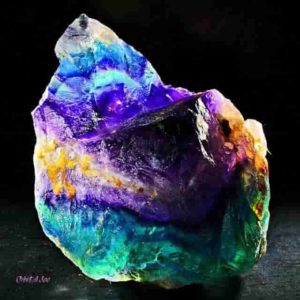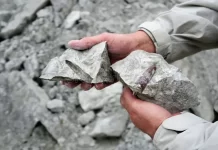
What Is Fluorite?
Fluorite is the mineral form of calcium fluoride. It belongs to the minerals of halides. It crystallizes in isometric cubic habit, although octahedral and more complex isometric forms are not rare.
Fluorite is a colorful mineral in both visible and ultraviolet light, with ornamental and lapidary uses in the stone. Fluorite is used industrially as a smelting flux and in the manufacture of certain glasses and enamels.
Fluorite’s purest grades are a source of fluoride for the production of hydrofluoric acid, the intermediate source of most fine chemicals containing fluorine. Optically clear transparent fluorite lenses have low dispersion, making them valuable in microscopes and telescopes, so lenses made from them exhibit less chromatic aberration. Fluorite optics are also usable in the far-ultraviolet and mid-infrared ranges, where conventional glasses are too absorbent for use.
What Is Fluorite Chemical Formula?
CaF₂
What is Fluorites specific gravity?
3.175–3.184; to 3.56 if high in rare-earth elements
What Is The Hardness Of Fluorite In Mohs Scale?
The Mohs scale of mineral hardness, based on scratch hardness comparison, defines value 4 as Fluorite.
What Are Fluorite Colores?
Fluorite comes in a wide range of colors and has consequently been dubbed “the most colorful mineral in the world”. Every color of the rainbow in various shades are represented by fluorite samples, along with white, black, and clear crystals. The most common colors are purple, blue, green, yellow, or colorless.
Why Is Fluorites Streak White?
Fluorite streak is white because this is the true color of the mineral’s powdered form. Impurities in a mineral specimen that cause color or tint are so insignificant in relation to the actual mineral content that they are not visible when powdered.
What is Fluorite Fluorescence?
The’ fluorescence’ phenomenon was named after fluorite in 1852, being one of the first fluorescent minerals to be studied. The fluorine element was named after fluorite as well. Fluorine is an essential component in the fluoride chemical ion. Under ultraviolet UV light, fluorite is often fluorescent.
The fluorescence is thought to be due to impurities of yttrium or other types of organic matter within the crystal lattice. The color of visible light emitted when a sample of fluorite is fluorescing appears to be highly dependent on where the specimen was collected.
Fluorescent fluorite colors are extremely variable, but blue is the typical color; yellow, green, red, white and purple are other fluorescent colors. Some specimens exhibit different colors under long and short wave UV light at the same time.
What is Fluorite used for?
Fluorite is used industrially as a smelting flux and in the manufacture of certain glasses and enamels. Fluorite’s purest grades are a source of fluoride for the production of hydrofluoric acid, the intermediate source of most fine chemicals containing fluorine.
What is the rarest color of fluorite?
Purple or violet is the classic color of fluorite, often competing for richness with amethyst. Blue fluorite is quite rare and collectors are looking for it. The brilliant yellow is very rare as well. Pink, black and colorless are the rarest fluorite colors.
Where fluorite can be found ?
In many places around the world, fluorite deposits are found. In Argentina, Austria, Canada, China, England, France, Germany, Mexico, Morocco, Myanmar (Burma), Namibia, Russia, Spain, Switzerland and the United States, some of the most significant finds are found.
Where can you find fluorite in North America?
One of the largest deposits of fluorspar in North America is located in the Burin Peninsula, Newfoundland, Canada. The first official recognition of fluorspar in the area was recorded by geologist J.B. Jukes in 1843. He noted an occurrence of “galena” or lead ore and fluoride of lime on the west side of St. Lawrence harbour.
It is recorded that interest in the commercial mining of fluorspar began in 1928 with the first ore being extracted in 1933. Eventually at Iron Springs Mine, the shafts reached depths of 970 feet (300 m). In the St. Lawrence area, the veins are persistent for great lengths and several of them have wide lenses. The area with veins of known workable size comprises about 60 square miles (160 km2).










